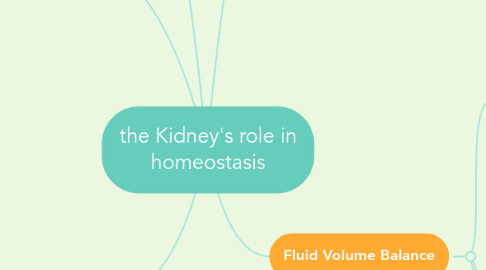
1. Blood pressure Control
1.1. the kidneys are to some extent able to autoregulate the pressure of blood entering the glomerular capillaries. This ensures that the glomerular hydrostatic pressure remains constant and GFR is maintained. Specialized vessels of the kidney, called the vasa recta, constantly monitor blood pressure as blood begins its passage into the kidney.
1.1.1. When BP drops, specialized juxtaglomerular cells called denta cells, secrete the hormone renin. Renin converts angiotensinogen to angiotensin I, which is then converted to angiotensin II that causes the BP to increase
1.1.2. The adrenal cortex secretes aldosterone in response to stimulation by the pituitary gland, which occurs in response to poor perfusion or increasing serum osmolality. The result is an increase in blood pressure. When the vasa recta recognize the increase in blood pressure, renin secretion stops.
1.2. If the filtering mechanism of the kidney is impaired, the kidney can not excrete nitrogenous waste products and regulate water and electrolytes in a result of fluid retention, which leads to hypertension.
2. Erythropoietin production
2.1. Erythropoietin production is stimulated by hypoxia and inhibited when the hypoxia is corrected, thus its production is controlled by the negative-feedback principle.
2.2. Erythropoietin is a glycoprotein that promotes the proliferation and differentiation of erythrocyte precursors in the bone marrow. Erythropoietin is necessary for the maintenance of a normal red cell count and prevention of anaemia.
3. Excretion of Wast roducts
3.1. The major waste product of protein metabolism is urea, of which about 25 to 30 g are produced and excreted daily.
3.2. Other waste products of metabolism that must be excreted are creatinine, phosphates, and sulfates.
3.3. Uric acid, formed as a waste product of purine metabolism, is also eliminated in the urine.
3.4. The kidneys serve as the primary mechanism for excreting drug metabolites.
3.5. Excess ions, such as sodium, potassium, calcium, magnesium, chloride, bicarbonate, is eliminated in the urine.
4. Fluid Volume Balance
4.1. Antidiuretic Hormone (ADH):is a hormone that is secreted from posterior pituitary gland in response to changes in osmolality of the blood.
4.1.1. Osmoreceptors in the hypothalamus detect small changes in the plasma osmolality and send signals to the posterior pituitary to secrete more or less ADH.
4.1.2. Sodium and negatively charged ion play an important role in determining ADH secretion.
4.1.3. ADH receptors are found in the collecting ducts of kidney tubules and ADH acts to open water channels found here. The fall in plasma osmolality then leads to a slowing-down of ADH secretion by negative feedback.
4.2. Aldosterone: is a steroid hormone secreted from the adrenal cortex.
4.2.1. It has its effect on the distal tubule of the nephron: the more aldosterone is secreted, the more sodium is reabsorbed
4.2.2. The secretion of aldosterone is not directly triggered by extracellular osmolality, but is regulated by a peptide, angiotensin II.
4.3. Atrial natriuretic peptide is released from cardiac atrial cells in response to an increased atrial stretch. It has five known major effects:
4.3.1. inhibition of aldosterone secretion by the adrenal cortex;
4.3.2. reduction of renin release by the kidney;
4.3.3. reduction of ADH release from the posterior pituitary;
4.3.4. vasodilation;
4.3.5. natriuresis and diuresis.
5. Regulation of Acid–Base Balance
5.1. The normal serum pH is about 7.35 to 7.45 and must be maintained within this narrow range for optimal physiologic function.
5.2. The kidney performs two major functions to assist in this balance.
5.2.1. The first is to reabsorb and return to the body’s circulation any bicarbonate from the urinary filtrate.
5.2.1.1. the renal tubular cells also generate new bicarbonate, which is then reabsorbed by tubules and returned to the body.
5.2.2. the second is to excrete acid in the urine
5.2.2.1. Catabolism produces acid compounds, in particular phosphoric and sulfuric acids, which lowers
